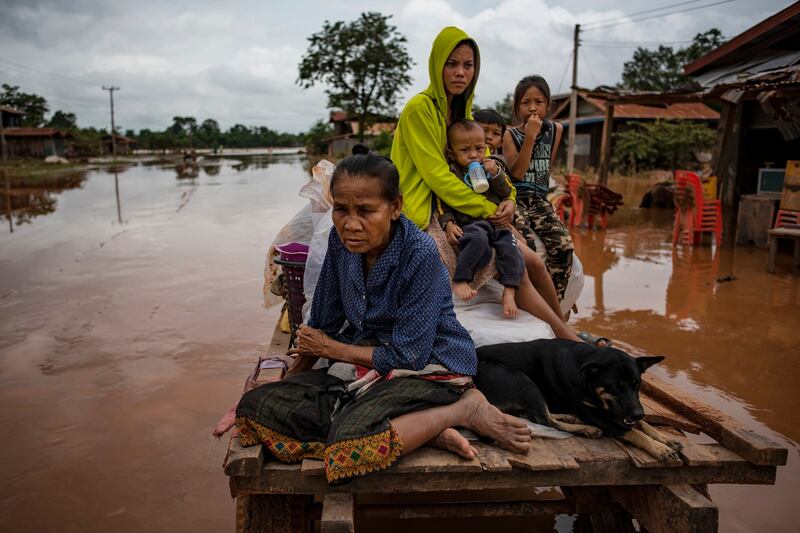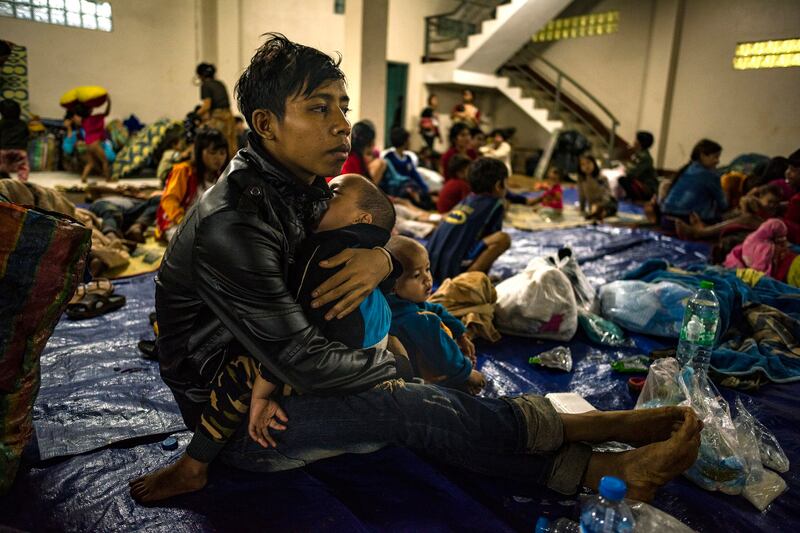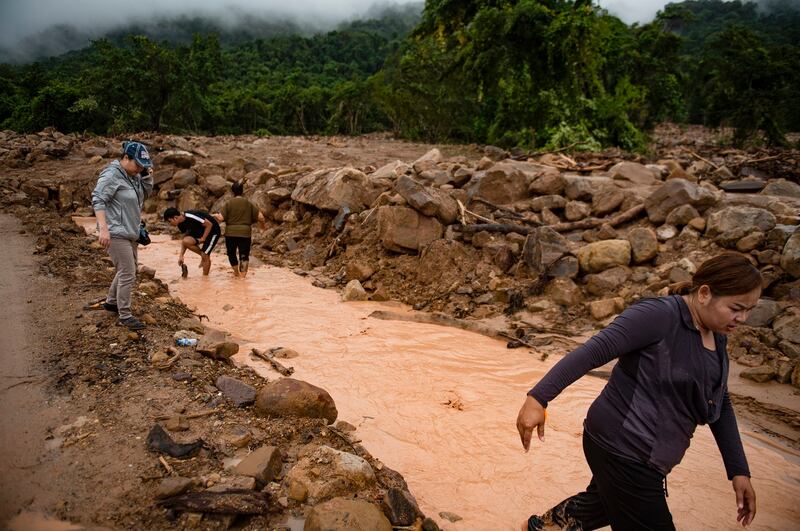It’s been five years since the collapse of a saddle dam on a tributary of the Mekong River in southern Laos caused the country’s worst flooding disaster in decades, but survivors say they have yet to be fully compensated.
On the night of July 23, 2018, water flowed over the collapsed dam at the Xe Pian-Xe Namnoy hydropower project in Champassak province, inundating 19 villages and killing 71 people downstream in Attapeu province. Some 14,400 residents were displaced by the floodwaters, forcing them to take shelter in hastily erected huts in temporary relocation villages.
Since the disaster, the government has pushed ahead with building more dams as part of its plan to make Laos the “Battery of Southeast Asia” by selling the generated electricity to neighboring countries. The Ministry of Energy and Mines has said it will build 100 of the dams by 2030 and signed memorandums of understanding for 250 other hydroelectric projects.
While authorities move on with new development, survivors told Radio Free Asia they are still struggling to pick up the pieces of their former lives, half a decade later.
“We haven’t received our final round of compensation from the government,” said a villager from Sanamxay district who, like others interviewed for this report, spoke on condition of anonymity, citing fear of reprisal.
“It almost seems as if they are waiting for us to die before they give it to us. One thing’s for sure – we always have to pay our electricity bills on time, but they haven’t compensated us.”

Another survivor of the collapse said that in the five years since the disaster, international NGOs have provided assistance with food, education, and health care.
“But help from the government and the dam developers has either come too late or not at all,” he said.
Survivors acknowledge that while their situation has improved slightly over the past five years, they are still struggling daily to earn enough money for basic necessities such as rice.
Still ‘making adjustments’
RFA spoke with an official from Sanamxay who said that the government and PNPC have built some infrastructure in resettled villages including roads, access to electricity and running water, and schools.
The official, who declined to be named because he was not authorized to speak to the media, said that in 2021, Attapeu province allocated 1,545 hectares (3,820 acres) of land to 852 families from four villages.
But he acknowledged that the government’s sixth and final round of compensation – which is supposed to account for the value of villagers’ assets that were washed away in the flooding, including jewelry, vehicles, and other personal property – has yet to be delivered.
“[The central government] is making adjustments to the amount that will be delivered, but they’ve delayed it many times already,” said the official, who declined to be named because he was not authorized to speak to the media.

Survivors received 835,000 kip (US$55) from the dam operator as compensation for each relative who died in the disaster. The PNPC also provided a monthly stipend for living expenses of 250,000 kip (US$17) per survivor initially, but now only orphans receive the stipend, which will run out when they reach 18 years old.
A PNPC official claimed that the company has already provided compensation to affected villagers of more than 835 billion kip (US$47.7 million). Speaking on condition of anonymity, he vowed that all resettlement projects would be completed by 2025 and that survivors could expect “better lives than before.”
Meanwhile, those who received land in 2021 told RFA that it is located on hillsides and lacks access to water for irrigation, making it unsuitable to grow rice and other crops.
UN experts have called on the Lao government to rectify the situation, calling it “shameful” that in the years since the collapse, many survivors continue to live in unsanitary temporary shelters, without access to basic services, while awaiting the compensation promised to them.
They have also expressed concerns that survivors and human rights defenders may face retaliation for bringing attention to their issues, which happened in 2019, and that at least two other dams in the area show similar signs of impending failure as the PNOC did, prior to its collapse.
Unhappy with resettlement
For those survivors who have received homes in resettlement villages, many told RFA they are unhappy with their situation.

The homes are in various stages of completion and often lack sitting rooms or plots for gardening, and are located far from their farms in their former villages, making it difficult to tend to their crops and livestock, they said.
“Some villagers choose to live at their old farms and let their sons and daughters occupy the resettlement homes,” said one survivor.
“The local health clinic is not finished yet, so when people get sick they have to travel to a hospital in town,” he added.
The conditions for those who are still living in what they expected would be temporary shelters are significantly worse. They must endure oppressive heat, as well as a lack of clean water and sanitation – all while struggling to earn a living.
As months have become years, with no end to their situation in sight, many have chosen to leave and try to start anew on their own, despite the enormous costs of building new homes.
One survivor who said he was unsurprised that residents of the resettle villages have started to leave, rather than waiting for government assistance that may never come, calling life in the resettlement villages “unbearable.”
Translated by Sidney Khotpanya. Edited by Joshua Lipes and Malcolm Foster.

